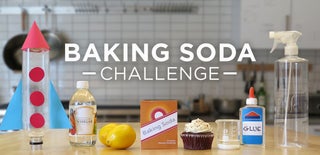Introduction: How to Make Lye From Baking Soda and Hydrogen Peroxide
I made this project because it took me WAY too long to find out how to make lye from stuff I personally had lying around the house. This is stuff others do not (the chemicals came from a chemistry kit). It took me quite a bit of digging to find out how to make lye from household materials that everyone has in their house (My two sources were a chemistry book from 1936 and a few forums [trust me this works, I asked my chemistry teacher and tested the lye]), and I want to share that so others don't have to do that digging. Also, I am writing this so I can enter it in the contest (:
There are lots of projects you can do with lye, such as make soap, magnetic nanoparticles, sodium metal, and many others. It is a caustic chemical though, so BE CAREFUL
Step 1: Equipment and Chemicals
To make lye you will absolutely need:
- Container (preferably glass)
- Hydrogen peroxide (You can buy this in the pharmacy at most stores. It's usually sold as "Hydrogen Peroxide" XD in a brown bottle. You probably already have some in your first aid kit)
- Baking soda (Sold as "Baking Soda")
- Something that can deliver gentle heat, like a desk lamp. See the picture if you have no idea what I am talking about.
- Something you can measure stuff with (either by volume or weight. If it is by weight, make sure your scale can measure grams. If it is by volume, make sure your measuring cup can measure milliliters)
- Patience
- Common sense (seriously)
- Something to stir with
These are optional things that will make it easier:
- Another container (the bigger the area the better. So you want it large. It does not necessarily have to be deep) that you are okay with potentially ruining, and can let it sit for a while
- Something to store your lye in (Once again, preferably glass, and it DEFINITELY needs a screw on top)
Also for safety (probably necessary) :
- Gloves (rubber, not cloth)
- Goggles (the splash guarding ones, look at the picture)
Step 2: Measure Out the Ingredients
It's time to use some math. Find out the percent of your hydrogen peroxide. Then figure out how many milliliters you want to use. Multiply those two numbers together (remember that percents are the percentage/100, so 3% is 0.03), and than multiply that by 7.25 to find the amount of grams of baking soda you need. To find out how many milliliters of baking soda, divide grams of baking soda by 2.2. You may need to do a bit of converting to get teaspoons of baking soda.
Step 3: Mix the Ingredients and Warm It Up.
After you are done measuring out the chemicals, put them in your container (you don't need to stir but you can). Put the container under a lamp like in the 3rd picture, so the bulb is about 3 inches inches away from the liquid. Make sure the bulb isn't touching the liquid. If you are having trouble getting the lamp to balance, place something heavy on the base (if you look on the right of the 3rd picture you will see my baking soda box). After a little bit, it should start to bubble. Check on it every once in a while to make sure it is not bubbling over or getting too hot (if it hurts to touch it, it is too hot). If it is too hot, take the lamp away for a bit, and then put it back. Once it has COMPLETELY STOPPED BUBBLING (make sure little bubbles aren't still being produced. Also the baking soda may not have completely dissolved), the first reaction is definitely over. Wait at least 30 minutes before you take away the lamp, just to be safe.
Step 4: Get the Dry Lye From the Solution
After it has stopped bubbling, it is time to get the lye crystals(more like lye hunk). Pour the liquid, and preferably only the liquid, in the original container into the second one if you have one. If you don't, just leave it as it is. Either way, find a place to put it where it won't be disturbed for a while and is out of children's reach. This will take a while, and the flatter the container the shorter it will take. Wait until the crystals are white, like in the 4th and 5th pictures.
Step 5: While You Are Waiting....
Here is the science behind this. There are actually two chemical reactions happening. One of them is
2NaHCO₃ + H₂O₂ → NA₂O₂+ 2H₂O + 2CO₂ (2 baking sodas + hydrogen peroxide →sodium peroxide + 2 waters + 2 carbon dioxides)
After that reaction this one happens:
Na₂O₂ + H₂O → 2NaOH + (O)↑ ( sodium peroxide + water → 2 sodium hydroxides + a single oxygen atom )
Which thus creates lye and water (after the gasses have bubbled out). Pretty neat, right?
Step 6: Store It.
Store the lye somewhere were children can't get it. Keep away from oxidizers. I am not responsible for any damage caused during or because of the products of this experiment. Keep in mind lye is also a very, very strong base which means it will burn you if you are not careful.
You can do some interesting stuff with lye. Since it is extremely basic (the opposite of acidic), you can do the purple cabbage experiment with it. You can also use it to make soap, magnetic nanoparticles, sodium (be careful), and many others. Have fun, but please be safe.

Participated in the
Baking Soda Challenge 2017













